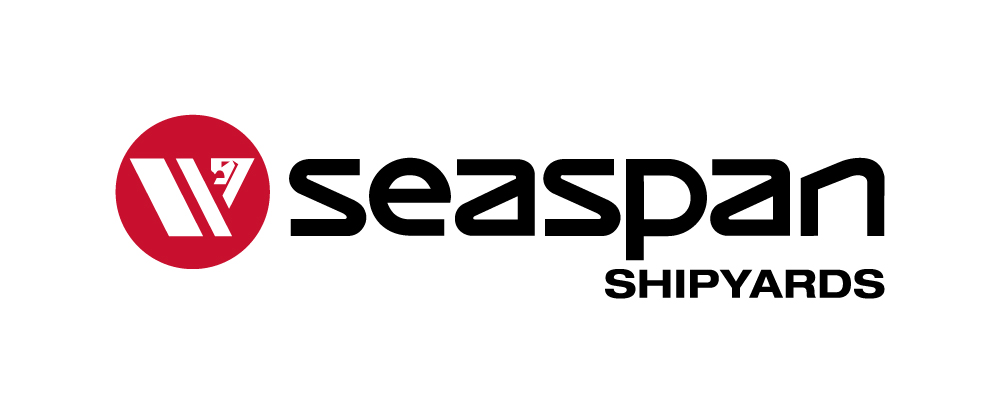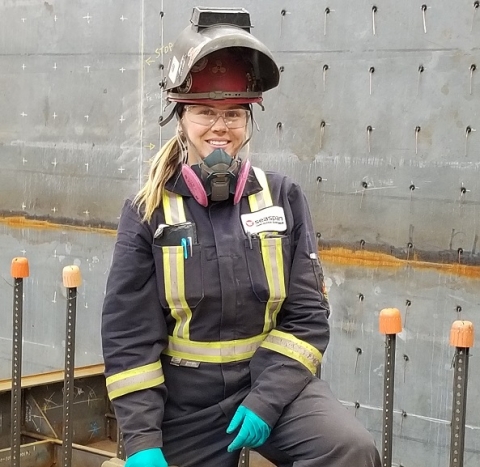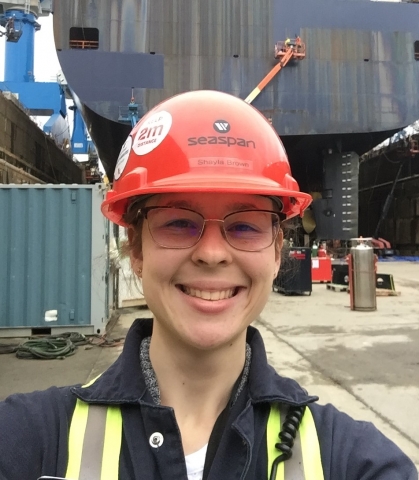
Canada’s Next Generation Oceanographic Science Research Ship
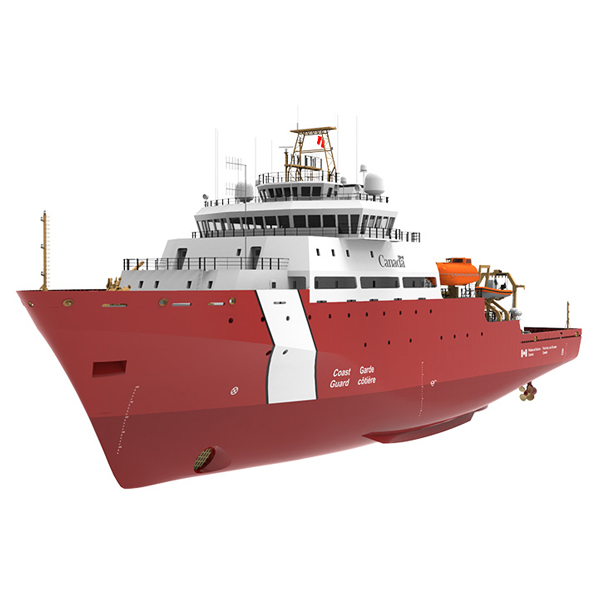
3D rendering of the offshore oceanographic science vessel (Seaspan Shipyards. Used with permission)

3D rendering of the offshore oceanographic science vessel (Seaspan Shipyards. Used with permission)
How does this align with my curriculum?
Learn about Canada’s newest Offshore Oceanographic Science Vessel.
Do you ever dream of adventures on the high seas? The sun on your face, the wind in your hair, and beautiful blue water as far as the eye can see? You are not alone. Oceans have long been the inspiration for grand adventures. But the importance of oceans goes far beyond this.
Oceans are incredibly important! They cover over 70% of the Earth’s surface and they produce over half of the world’s oxygen. They also transport heat from the Equator to the poles. This affects weather patterns and impacts our climate.
Canada is the only country in the world whose landmass directly touches three different oceans.
Try This!
Can you name the three oceans without looking at a map?
The coastline of Canada touches the Pacific, the Arctic, and the Atlantic oceans.
Did you know?
Canada has the longest coastline in the world. It is 247 007 km long.
Canada and the Marine Sector
With all of that coastline and access to oceans, it is not surprising that thousands of Canadians are employed in the marine sector. People in this sector are involved in fishing, transportation, offshore oil and gas, tourism, shipbuilding and more.
For a country like Canada, it is essential to have a well-equipped Navy and Coast Guard to protect and defend its shores. To meet this need, the Government of Canada has launched a National Shipbuilding Strategy. As part of this strategy, two Canadian shipyards are working hard to supply the Navy and Coast Guard with new, state-of-the-art ships.
Seaspan Shipyards, located in British Columbia, is building a number of these ships. At Seaspan Shipyards, we are really excited that our designers and engineers get to work closely with the Canadian Coast Guard to design and build next-generation research vessels, such as the Offshore Oceanographic Science Vessel (OOSV).
The Offshore Oceanographic Science Vessel
OOSV will be the primary oceanographic science research vessel for Fisheries and Oceans Canada. It will mainly sail in the cold North Atlantic Ocean, as well as in the Arctic and the Pacific oceans. It is designed to do three main things:
- support marine surveys and research on ocean currents and the seabed;
- monitor how oceans are affected by winds; and
- gather information that will increase our understanding of the impact of climate change on oceans.
To do all of these things, you need a pretty big ship! The OOSV will be about 87.9 m long. This is about the same length as eight yellow school buses placed end-to-end. It also has space for 60 people to live. This includes 34 crew and 26 scientists.
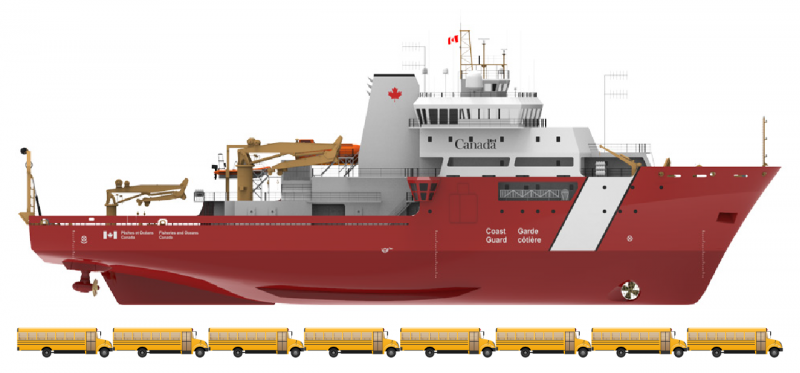
Image - Text Version
Shown is an illustration comparing the size of the OOSV with eight school buses. Illustrations of eight typical yellow school buses are lined up end to end directly below a computer generated illustration of a side view of the ship.
Not only does it need to be big, it needs to be stable. Building a ship that is stable enough to allow scientists to run experiments while at the same time manoeuvrable enough to get around icebergs is an exciting challenge! To have some idea of what this would be like, imagine being in science class trying to carefully measure a liquid into a flask while at the same time standing on a platform that is moving up, down, and sideways. This is what it is like doing science on the high seas!
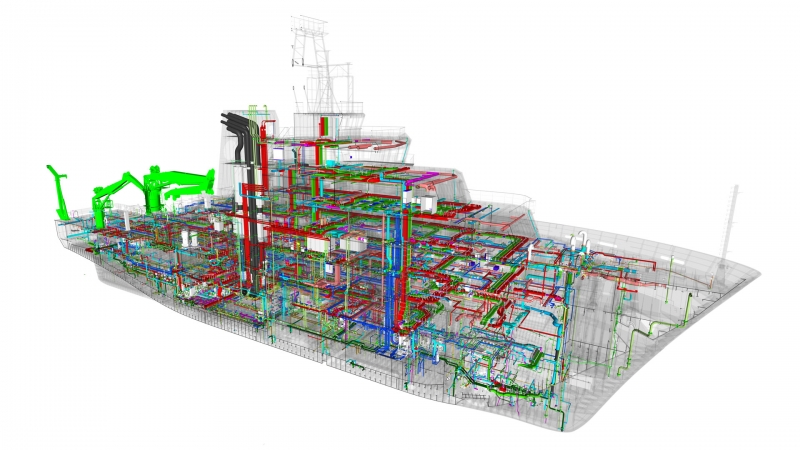
Image - Text Version
Shown is computer rendering of the interior of the OOSV.
The internal layout of the ship has different systems highlighted in different colours. There are many complex systems shown.
Doing scientific research in the northern oceans has some unique challenges. To face these challenges and collect the data we need, we need a ship that:
- Will operate in very cold environments. This means that the steel we use to build the ship will need to be thicker than ships that sail in warmer waters.
- Has a that can be lowered or raised in order to provide more stability for the science experiments. This will help to protect the sensitive scientific equipment and sensors from underwater obstacles such as ice and coral.
- Has a stabilization system to counteract the movements of the waves. Less movement makes for better, more reliable science experiments as well as safe and accurate data collection.Has a really big external door that is two decks high so that big winches can put out and take in large scientific equipment.
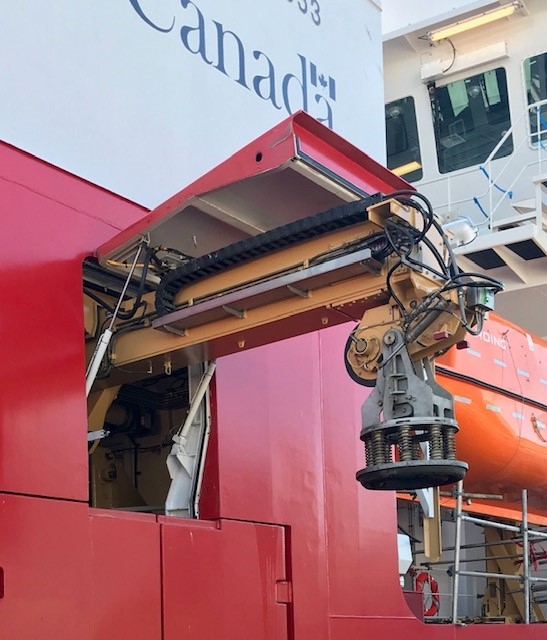
Image - Text Version
Shown is a photograph of the side of a large ship. The government of Canada logo is clearly visible on the side.
On the side of the hull is a large hinged door that has been lifted upward, a lot like a non-folding garage door. It rests parallel to the ground.
Extending out through the door, and ending just past the door, is a large metal beam. The beam is connected by tubes, wires and hinged parts to a complicated metal sampling device.
- Has a sea water sampling system to study seawater properties, such as oxygen levels, temperature, and .
- Has six labs for doing different kinds of science, including:
- a general-purpose lab
- a chemical lab
- a salinity measuring/climate control lab
- a computer lab
- a seawater sampling lab
- an lab
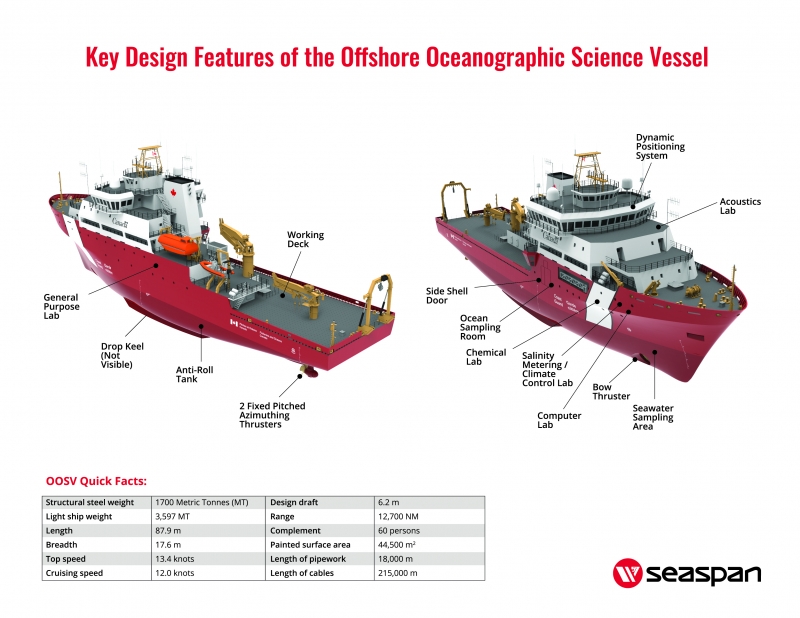
Image - Text Version
Shown are two 3D renderings of the OOSV, a chart of statistics, and the header "Key Design Features of the Offshore Oceanographic Science Vessel".
The image on the left shows the left, or port side, of the ship. It has a large red hull and a white superstructure.
The light grey working deck has two large yellow lifting arms emerging from it.
Near the middle of the port side on the upper part of the desk is an arrow indicating the location of the General Purpose Lab.
Below the hull is an arrow indicating where the drop keep will be. The keel itself is not visible.
Along the lower part of the hull, towards the rear or stern of the ship, is an arrow indicating the location of the anit-roll tank. At the stern of the ship are two fixed thrusters that resemble small propellers. These are labelled.
The image on the right shows the right, or starboard, side of the ship. At the top of the superstructure in the bridge area. In this area is an arrow pointing to the location of the dynamic positioning system.
On the port side just below the bridge is an arrow indicating the location of the acoustics lab.
On the hull, below the stern part of the superstructure is an arrow pointing to the locations of the side shell door. This is the door mentioned in the text and in the previous image.
Adjacent to the door and slightly toward the front, or bow, of the ship, is an arrow pointing to the location of the ocean sampling room.
Further forward in the upper part of the hull is an arrow pointing to the location of the chemical lab.
Still farther forward is an arrow pointing to the location of the salinity metering and climate control lab.
Slighly more forward and adjacent to the previous lab is an arrow pointing to the location of the computer lab.
On the lower part of the hull fairly close to the bow of the ship is an arrow pointing to location of the bow thruster.
The section furthest at the stern is an arrow pointing to the location of the seawater sampling area.
Next...
Shown is a table with the header "OOSV Quick facts".
The chart includes 12 characteristics of the ship with related data.
The Structural steel weight is 1 7600 Metric Tonnes (MT); the Light ship weight is 3 597 MT; the Length is 87.0 metres; the Breadth is 17.6 metres; the Top speed is 13.4 knots; the Cruising speed is 12.0 knots; the Design draft is 6.2 metres; the Range is 12 700 nautical miles (NM); the Complement is 60 persons; the Painted surface area is 44 500 square metres; the Length of pipework is 18 000 metres; and the Length of cables is 215 000 metres.
It will take about four years to build this ship. Once it is complete and in the hands of the Canadian Coast Guard, the crew and scientists will be doing lots of scientific experiments. This will include things like:
- analyzing the causes of ocean changes by season, year over year, and even up to 10 years.
- taking high-resolution digital photographs to help us detect and understand the causes of long-term changes in marine ecosystems.
- collecting and analyzing water samples to understand the effects of water chemistry on reefs and corals.
- making oceanographic observations of everything from the continental shelf to the deeper water of the Northwest Atlantic Ocean.
- studying materials lying on top of the ocean’s bedrock to better understand the seafloor.
The more information we can get from the oceans, the better we will be able to understand the health of oceans. This understanding will help us make decisions that will positively impact ecosystems and combat climate change.
Building the Future Together
Building these very complex vessels requires lots of people. This includes engineers, designers, welders, painters, accountants and project managers. It also includes a lot of materials. These are coming from the more than 660 Canadian suppliers, mostly small and medium-size companies. Together, thousands of people from across Canada will be working together to complete this amazing ship.
Could you see yourself being one of them?
To set sail on a course for adventure, check out these Let’s Talk Science career profiles of people in the marine industry:
Let’s Talk Science appreciates the work and contributions of Wendy Keyzer from Seaspan Shipyards in the development of this Backgrounder.
Seaspan Shipyards
Located on the Pacific Northwest Coast, Seaspan Shipyards operations include Vancouver Shipyards, Vancouver Drydock and Victoria Shipyards. As a result of its diversity and capacity, Seaspan Shipyards is unique in its ability to provide a complete range of shipyard services including new construction, conversion, refit, repair, life-cycle maintenance and refurbishment work for naval, research and commercial vessels including cruise-ships, deep-sea vessels and submarines.
References
Government of Canada, P. S. and P. C. (2021, June 4). National Shipbuilding Strategy. Defence and marine Procurement - Buying and Selling - PSPC Services - Public Services and Procurement Canada - Departments and agencies - Canada.ca. Retrieved December 6, 2021, from https://www.tpsgc-pwgsc.gc.ca/app-acq/amd-dp/mer-sea/sncn-nss/index-eng.html
Government of Canada, P. S. and P. C. (2021, April 28). Offshore oceanographic science vessel. Large vessel shipbuilding projects – Shipbuilding projects to equip the Royal Canadian Navy and the Canadian Coast Guard – National Shipbuilding Strategy – Defence and marine procurement – Buying and Selling – PSPC Services - PSPC. Retrieved December 6, 2021, from https://www.tpsgc-pwgsc.gc.ca/app-acq/amd-dp/mer-sea/sncn-nss/oceanographique-oceanographic-eng.html.
Seaspan Shipyards (n.d.) Offshore Oceanographic Science Vessel. Retrieved from https://nss.seaspan.com/project/offshore-oceanographic-science-vessel/
